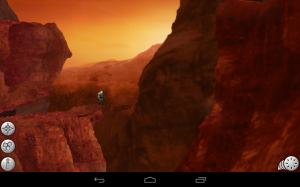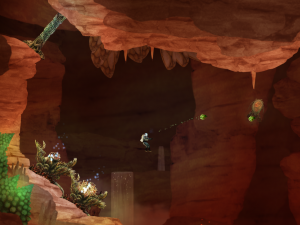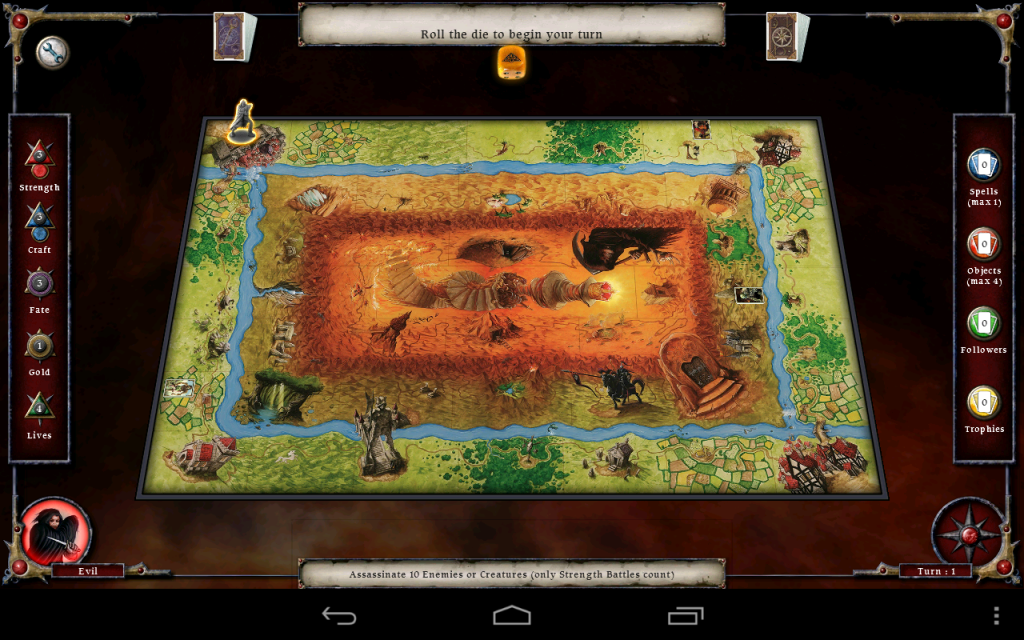Crazy Monkey Studios’ Empire is a ‘light’ strategy game for mobile platforms and PC (1) that contains some interesting ideas and a striking dark-fantasy aesthetic, but ultimately falls short of its promise.
Android Games
Quick impressions: Transport Tycoon (Android version)
This is the mobile version of the PC strategy classic, a title I loved as a kid – I still own the official game guide. There are plenty of minor differences (most notably, the random map generator is gone, replaced with a long list of scenarios); but on the whole, this is a faithful adaptation (1). Each map presents the player with scattered towns and industries, which supply and demand various types of cargo; for example, towns both generate and require passengers, while a steel mill requires iron and coal from their respective mines, and produces steel that can then be shipped to factories. Scenario objectives can be open-ended ( “make X dollars”) or more prescriptive (“move Y units of a given cargo”). To meet these objectives, players buy vehicles (buses, planes, trains, ships, and more); lay track and build stations;; and reinvest the profits into new routes and better vehicles, a cycle as pleasant as it was 20 years ago. The largest scenario I’ve played so far, a medium-difficulty freeform map, did drag once I was past the initial difficulty hump (2), but it ended at about the right point to avert boredom – and besides, this is probably why the game offers multiple scenarios.
The key issue, as with any mobile port of an established game, is how well the controls/interface work with a touchscreen. Here, I think the answer is “not badly”. Everything – font, buttons, tiles – is nice and big, even on a 7” screen, and the developers have been quite clever about adapting the controls. However, it’s not perfect. For instance, in the PC version, railways are built by clicking on the desired tile, easy with a mouse but probably too fiddly for touchscreens. In the Android version, you tap the start tile, then select the direction you’d like to build in, and finally extend the line just by tapping a button. This works well for shorter and less complex routes, but the need to lay segments of track one at a time means that lengthy, curvy rail routes can still be a hassle – I could really have used a mouse when building my longest (and most profitable) line (3). Similarly, the simple act of telling a vehicle to go from station A to station B requires that I tap through several screens and often fumble with scrolling the map; over the course of a game, that adds up. And while I don’t remember if this was present in the PC version, I would really like some way to sort vehicles by profitability – it’s easy to mock “spreadsheet” games, but spreadsheets were invented for a reason! Still, I should stress that on the whole, the interface works reasonably well, well enough for the underlying game to shine through.
Overall, I quite like Transport Tycoon so far. There are other strategy games on Android, and other PC ports; but this is one of the few to combine PC-grade scale with a mobile-friendly interface. Definitely worth a look if you enjoyed the original, or if this sounds like your cup of tea.
Technical note: The Android version apparently suffered from nasty lag when it was launched; however, the game ran smoothly by the time I bought my copy.
(1) Perhaps it’s a little too faithful in its aesthetic – the low-res sprites have not aged well.
(2) Effectively, I was making enough money that I could snowball.
(3) Ideally, I’d like to see the game calculate optimal track layouts based on the start and end points, but oh well.
Waking Mars: The Verdict

Science fiction, it is said, is the literature of ideas – a genre about going where nobody has gone before. Its iconic emotion is the “sense of wonder”; its iconic heroes are explorers and scientists. Now an indie game, Tiger Style’s Waking Mars, has distilled that spirit into a remarkable ten-hour package.
I wrote my first impressions of Waking Mars last year; you play an astronaut exploring a cave complex beneath Mars. Each area is home to a certain amount of Martian wildlife, and to progress to the next, you must increase the amount of life – the biomass – above a certain threshold. To do this, you flit about on a 2D, side-scrolling map of the area, planting seeds, tending to the newly grown plants, and collecting their secreted seeds to plant elsewhere or feed to animals. (While the game does look like a platformer, I found this is not the case; it emphasises exploration, not reflexes or timing, and in fact I recommend turning the difficulty down so you can focus on its strengths.)
This is a simple premise, but it’s done wonderfully. Over time, you encounter more, and more varied, species, each with their own ecological niche. There’s the Halid, your workhorse throughout the game: a plant with moderate biomass and the ability to produce a profusion of seeds. There are little scurrying creatures, which reproduce after eating Halid seeds; individually their biomass is trivial, but if you can fill a room with them… There are plants that offer high biomass, but that kill other organisms. And that’s just the tip of the iceberg. Along the way, you discover more and more species, more and more of the planet’s mysteries, and I wish I could spoil some of these for you – more than once, they made me think, “wow!”
Quick impressions: Talisman: Prologue
Talisman: Prologue is a recently released Android/iOS adaptation of an old board game (which I have not played), Games Workshop’s Talisman. TP is a solitaire game in which the player controls a single high fantasy adventurer (a warrior, troll, assassin, etc), who moves around a board, attempting to solve a “quest” (kill X monsters, bring the princess to Y castle) chosen at the start of the game.
Note my choice of words: the character moves around the board, not the player. That’s because almost everything in TP – how far the adventurer moves, the monsters he/she encounters, whether s/he defeats the goblin, whether the enchantress turns him/her into a frog – is determined almost entirely by chance. Never mind strategy or making interesting decisions; in TP, there are very few decisions at all, and in mechanical terms, that makes it a lousy game.
So what’s the point of TP, then? Its theme, which I think you will enjoy to the extent that (a) your imagination can construct a story from card art and random numbers (TP‘s high production values help), and (b) you like ‘80s high fantasy. The last time I played, my assassin stumbled on a mischievous imp (drew an Imp card), who teleported him to a cave (I rolled a certain number), where he slew a serpent (drew a card, rolled a die, and compared his die roll + strength against the serpent’s) and discovered a rich hoard of gold (another die roll). There is a cool and exciting, if brief, story in there, even if I had to fill in all the details in my head.
The last thing I should note is that the game’s own designers seem very aware that it lacks the depth for sustained play. The game’s quests – and hence, its play sessions – don’t last very long. However, finishing each quest unlocks both new quests and new adventurers, which is what provides the incentive to return.
Overall, I can’t recommend TP for gamers in search of a meaty ruleset, a tense challenge, or even much in the way of player agency. However, for those who don’t mind being spectators while the dice do the work, TP is worth a look as a coffee-break-length ticket to Fantasyland.
A technical note: while the game is playable on my 7” device (Nexus 7), the font is too small for my liking. People with larger screens may find the font more appropriately sized.
Kickstarter campaign opens for a Starbase Orion Android/Mac/PC port
Following up on a news item I posted last year, Chimera Software has launched its Kickstarter campaign for an Android/Mac/PC port of Starbase Orion. SO is a 4X space strategy title that – if the trailer is any indication – owes a clear debt to Master of Orion, and based on what I’ve heard about its current, iOS incarnation, I’m quite excited by the prospect of an Android version.
Chimera is seeking $40,000 for the campaign (it’s presently at $2,695), which closes on 6 March.
Choose your own adventure IN SPAAACE: The Fleet
The Fleet is a CYOA-esque piece of interactive fiction from indie outfit Choice of Games (I wrote about Choice of Broadsides, one of their earlier releases, last week). The Fleet trades in Broadsides’ sailing ships for space cruisers, and costs money ($3) whereas Broadsides was free, but in mechanical terms, the two are very similar. Both take about 30-60 minutes to play through, and both are about making choices that play to the main character’s strengths. (For instance, attempting fancy manoeuvres in Broadsides will lead to disaster if the player character has a low Sailing stat.)
Fleet’s greatest failing is that it lacks Broadsides’ charm – Fleet’s setting isn’t just space opera, it’s stock standard space opera. It will contain nothing new to anyone who’s read or watched much science fiction. Still, its plot – dealing with the trials and tribulations of a refugee fleet fighting to reclaim its homeworld – is serviceable, and I was thoroughly satisfied with the ending I achieved: I finished as a true statesman, someone who’d led his people – and the galaxy – to a better tomorrow. There are other endings out there, but I’m reluctant to replay the game to discover them – I don’t want to mar my first ending! Overall, a decent time-killer.
If you’d like more detailed looks at The Fleet, Pocket Tactics and Jay Is Games both have helpful reviews!
Choose your own seafaring adventure: Choice of Broadsides
“Fire the starboard broadside!” shouts the Captain.
Cannons roar as H.M.S. Courageous attacks the enemy frigate. As one of the junior officers–really, more of an officer in training–you command three guns on Courageous’s main gun deck. The guns of the battery next to yours fire, leaping back against the heavy ropes that prevent them from smashing across the ship. Clouds of white smoke billow about you as you give your gun crew the commands to ready your battery’s cannons: “Swab! Powder! Wadding! Shot! Run out the guns!”
The Captain yells out, “Fire as the guns bear!” You give your gun crews orders to load and fire as quickly as they can, without waiting for the rest of the broadside.
They swab out the bore, push in a charge of powder, push wadding down on the powder, load the shot, push the gun out through the gunport, and fire the cannon, with you commanding each step of the process. “Swab, powder, wadding, shot, fire! Swab, powder, wadding, shot–”
The world turns upside down as the enemy’s broadside rips through the hull some ten feet away.
As the enemy cannonball tears through the side of the ship, giant splinters of wood fly through the air. One of the splinters, perhaps a yard long, rips through the stomach of Davies, a sailor under your command. A fragment of a cannon ball smashes Fisher’s arm, mangling it horribly. Your sailors seem stunned by the carnage, standing in shock while Davies and Fisher scream in agony.
What do you do?
A. Attend to the wounded personally–the safety of my sailors is my top concern.
B. Give some quick orders for them to be taken to the surgeon in the cockpit, then turn back to my duty in commanding the guns.
C. With a gut wound like that, Davies is done for, but Fisher can still be saved. I order some sailors to take Fisher to the cockpit but leave Davies on the deck to die. I need the extra sailors to use the guns effectively.
D. My duty to the ship outweighs my duty to two sailors. I ignore the wounded and concentrate on firing my guns as quickly and accurately as I can.
That is the opening of Choice of Broadsides, a free, short (30-60 minutes), and very good “choose your own adventure”-type game for Web, Android, and iOS. If you have ever read CS Forester, Patrick O’Brian, or one of their ilk, you will be right at home here: Broadsides chronicles your adventures as an officer in the Royal Navy of Great Britain Albion, during war against Napoleonic France Gaul. You start as a lowly midshipman, but you won’t stay that way! By the end of the game, I’d retired as an admiral, laden with honours – though not quite as much prize money as I’d hoped…
Humble Bundle for Android #4: The Highlights (Waking Mars, Swords & Soldiers, Crayon Physics)

So I’ve had a few days to play around with the current Humble Bundle, Android #4– by way of introduction, this offers Android, PC, and Mac copies of five indie games (Splice, Eufloria, Waking Mars, Crayon Physics Deluxe, and Superbrothers: Sword & Sworcery EP) on a pay-what-you-want basis. Paying more than the average (currently $6.61) will add another six games: Machinarium, Avadon: The Black Fortress, Canabalt, Cogs, Swords & Soldiers HD, and Zen Bound 2.
Of these, I’ve dipped very briefly into Eufloria, Superbrothers, and Machinarium, but I’ve preferred to spend my time with Waking Mars, Crayon Physics (which I’ve owned on Steam for a while), and Swords & Soldiers (both on Android and on Steam). Brief thoughts below…
Starbase Orion Android/PC port to be Kickstarted next year!
Good news, fellow Android gamers! Starbase Orion, Chimera Software LLC’s Master of Orion-style strategy game for iOS, may come to Android next year. I sent an email to developer Rocco Bowling, and this was his reply:
I will be holding a KickStarter campaign early next year to help raise funds to port SO to Android and PC. If it gets funded, it’ll get ported!
So keep an eye out for that campaign, folks!
